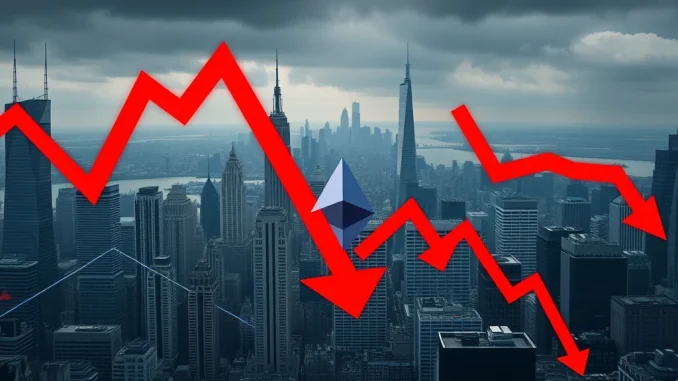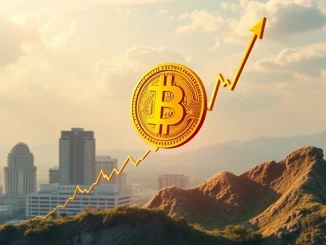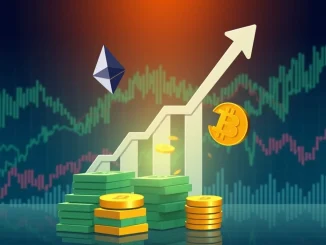
A significant tremor has been felt in the Ethereum market as massive ETH inflows flood derivatives exchanges. Are we on the cusp of another price downturn? Recent data reveals a staggering 77,000 ETH surged into these exchanges on April 16th, a volume unseen in recent months. This spike has ignited concerns among analysts and investors alike, drawing parallels to previous instances where similar inflows preceded notable Ethereum price drops. Let’s dive into what this means for the market and what factors are at play.
Decoding the 77K ETH Inflows: What’s Behind the Spike?
According to CryptoQuant contributor Amr Taha, this 77,000 ETH inflow is not just a blip on the radar. It’s a significant event, marking the largest such influx in recent memory. But what exactly does it mean when we see such large ETH inflows into derivatives exchanges?
- Potential Bearish Positioning: Large inflows to derivatives exchanges often indicate that big players, sometimes referred to as “whales,” are opening short positions. They might be betting on a price decrease, aiming to profit from Ethereum’s potential decline.
- Hedging Strategies: Alternatively, these inflows could represent hedging activity. Investors holding large ETH positions might be using derivatives to protect themselves against anticipated price drops, essentially buying insurance for their holdings.
- Speculation and Leverage: Derivatives exchanges are breeding grounds for speculation due to the leverage they offer. Inflows could be fueled by traders seeking to amplify their bets on Ethereum’s price direction, whether up or down, but in this context, the bearish sentiment is gaining traction.
Echoes of the Past: Historical Patterns and Ethereum Price Prediction
History often rhymes, and in the crypto market, past patterns can offer clues about future movements. The recent ETH inflows are particularly concerning because they mirror events that preceded Ethereum price corrections in the past. Let’s look at the dates mentioned:
| Date | Event | Subsequent Ethereum Price Action |
|---|---|---|
| March 26 | Significant ETH inflow to derivatives exchanges | Ethereum price drop |
| April 3 | Another notable ETH inflow to derivatives exchanges | Ethereum price drop |
| April 16 | Massive 77,000 ETH inflow to derivatives exchanges | To be determined, but raises concerns |
These historical parallels are fueling concerns that we might be witnessing the early stages of another Ethereum price prediction pointing downwards. While past performance isn’t a guaranteed predictor of future results, these patterns are hard to ignore and warrant caution.
The Gloom of Bearish Crypto Sentiment: Why the Market Feels Jittery
The crypto market is currently grappling with a palpable sense of unease. This bearish crypto sentiment isn’t solely based on ETH inflows; it’s a confluence of factors creating a perfect storm of uncertainty. What’s contributing to this negative outlook?
- Macroeconomic Headwinds: The global economic landscape is far from smooth sailing. Inflation remains a persistent worry in many parts of the world, and central banks are walking a tightrope trying to manage it without triggering recessions.
- Geopolitical Instability: Escalating tensions, particularly the U.S.–China trade disputes mentioned in the original article, add another layer of complexity. Such global uncertainties often lead investors to become risk-averse, impacting assets like cryptocurrencies.
- Regulatory Scrutiny: The ever-present shadow of regulation looms over the crypto market. Uncertainty about future regulations in major economies can dampen investor enthusiasm and contribute to bearish trends.
Macroeconomic Tensions Crypto and the US-China Factor
The original content specifically highlights escalating U.S.–China trade tensions as a contributing factor to the current market sentiment. Macroeconomic tensions crypto assets particularly sensitive to because they are often viewed as risk-on investments. When global economic stability is threatened, investors tend to flock to safer havens, and riskier assets like cryptocurrencies can experience outflows.
The trade tensions between the world’s two largest economies inject volatility and uncertainty into the global financial system. This uncertainty translates into pressure on risk assets, and crypto is no exception. Investors are carefully monitoring these developments, and the ETH inflow to derivatives exchanges could be a reflection of this heightened anxiety.
Navigating the Uncertainty: Actionable Insights for Crypto Investors
So, what should crypto investors do in the face of these concerning signals? Here are some actionable insights to consider:
- Stay Informed: Keep a close watch on market data, including exchange inflows and outflows, on-chain metrics, and macroeconomic news. Knowledge is your best defense in volatile markets.
- Manage Risk: Review your portfolio risk exposure. Consider reducing your exposure to highly volatile assets if you have a low-risk tolerance, or implement hedging strategies using derivatives if appropriate for your risk profile and understanding.
- Diversify: Don’t put all your eggs in one basket. Diversification across different cryptocurrencies and asset classes can help mitigate risk during market downturns.
- Consider Long-Term Perspective: Remember that crypto markets are cyclical. Bear markets are a part of the cycle. If you are a long-term investor, focus on the fundamental value of your investments and avoid making impulsive decisions based on short-term market fluctuations.
Conclusion: A Word of Caution Amidst Market Jitters
The surge in ETH inflows to derivatives exchanges is a clear signal that bearish sentiment is gaining ground in the Ethereum market. Coupled with existing macroeconomic uncertainties and geopolitical tensions, the crypto landscape is undeniably fraught with caution. While no one can predict the future with certainty, these indicators suggest that investors should proceed with vigilance and a well-thought-out risk management strategy. The coming days and weeks will be crucial in determining whether this ETH inflow truly foreshadows another price correction or if it’s merely a temporary market wobble. Stay informed, stay prepared, and navigate these uncertain times with prudence.



